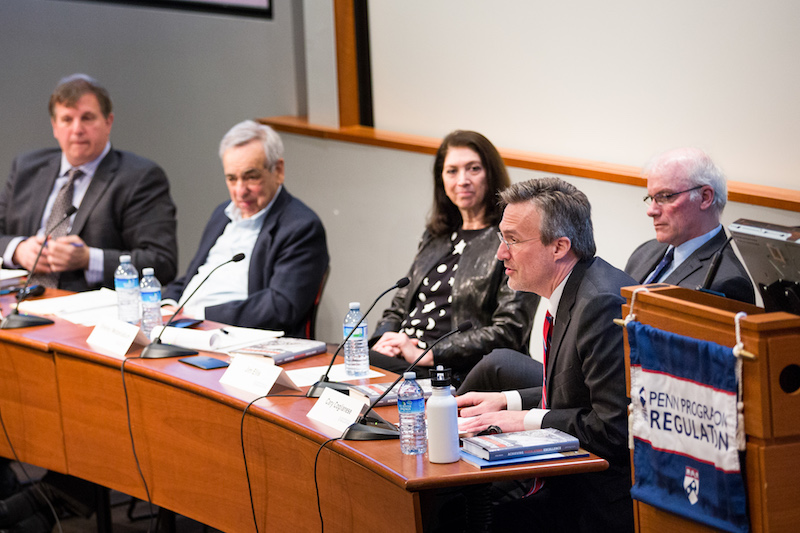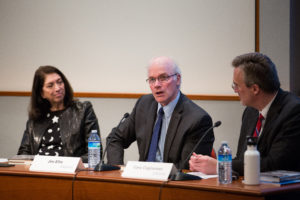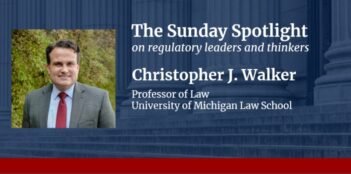
Contributors to a new book outline the prerequisites for success by regulatory agencies.
Since the start of Donald Trump’s term as President, Congress and federal agencies have targeted numerous regulations to be cut, postponed, or suspended, marking a major attempt to reduce regulation—and sparking debate over the quality and future of our regulatory system.
As regulators began to face growing scrutiny in the new Administration, the Penn Program on Regulation (PPR) convened a panel discussion around the new book, Achieving Regulatory Excellence, edited by PPR’s Director, Cary Coglianese. The book defines the components of superior regulatory performance and charts a path for how regulators can seek to excel, even possibly in today’s political environment.
Coglianese, the Edward B. Shils Professor of Law at the University of Pennsylvania and the faculty advisor to The Regulatory Review, moderated the panel discussion, which featured several of the authors of the book’s chapters.
A common theme in the panel discussion emerged that emphasized the importance of empathetic engagement with members of the public. For example, panel member Jim Ellis—the president and CEO of the Alberta Energy Regulator (AER), which is Alberta, Canada’s single regulator of energy development—spoke about the need to engage stakeholders.

Adam M. Finkel discusses competing values important to regulators.
Ellis said that social media has led to an increased spread of information and transparency in society, and that citizens now expect the same updates and transparency from regulators. He said that, although most energy regulators focus on technical issues related to oil and gas development, the AER has also hired social scientists who can help the agency engage with the diverse stakeholders in the province, including landowners, indigenous communities, industry representatives, and members of environmental organizations.
Coglianese echoed Ellis’s emphasis on empathy. Regulation may raise complex technical issues, he said, but fundamentally it is highly relational. It involves working with the public to identify and solve problems. “Regulatory excellence is about people excellence,” he stated.
Fellow panel member, Adam Finkel, a Senior Fellow at PPR, also endorsed the importance of listening to the public and warned against the danger of what he called chauvinism. For Finkel, regulatory chauvinism occurs when agency staff see their primary task as protecting their organization against external forces, such as criticism from members of the public, rather than attaining the agency’s stated mission.
According to Finkel, empathetic engagement in this context requires the regulator to take very seriously concerns from the public that a proposed action might be inconsistent with its mission, while guarding against the temptation to “go along to get along” by acceding to a stakeholder demand regardless of its effect on the mission.

Panelists field questions from the audience.
Panel member Howard Kunreuther, the James G. Dinan Professor of Decision Sciences and Business and Public Policy at the University of Pennsylvania’s Wharton School, shifted the panel discussion to lessons that regulators might be able to learn from the private sector, specifically the insurance industry.
“Ideally, insurance premiums should be risk-based and regulation should also be guided by risk-related considerations,” stated Kunreuther. Regulation properly attentive to risk, and to quality risk analysis, can create incentives for regulated businesses to make positive changes. “In designing regulations, one needs to consider the costs associated with specific requirements in relation to their expected benefits to the key interested parties and society,” Kunreuther said.
Panel members also discussed how regulators must prepare for the high-stakes decision-making that top-quality regulation demands. Shelley Metzenbaum, a Senior Fellow at the Volcker Alliance, noted the complexity of regulatory decisions and the importance of training regulators in the skills needed to make tough calls.
“Most regulatory decisions are not simple,” she said. “Regulatory excellence requires skills in complicated decision-making.”
Adequate funding for regulators is also critical, Metzenbaum said.

Jim Ellis discusses his experience at the Alberta Energy Regulator.
Commentator John J. DiIulio, Jr., the Frederic Fox Leadership Professor of Politics, Religion, and Civil Society at the University of Pennsylvania, also emphasized the need for regulators to have adequate resources.
DiIulio noted that, since the 1960s, thousands of pages of rules have been added to the Federal Register, but the number of civil servants who enforce these rules has grown at a comparatively anemic rate.
“Instead of hiring more civil servants, we have armies of private contractors,” DiIulio said. “Our country spends more on defense contractors than on the entire federal workforce.”
Given regulators’ constrained resources and the current hostility to regulation in Washington, D.C., the panel considered how regulators might excel in today’s more challenging environment.
Finkel encouraged a change to the language used to discuss regulation. “Politicians who say they are opposed to strict regulation nevertheless often campaign on a pro-regulation agenda,” Finkel argued. “For example, many of these anti-regulation candidates endorse tighter restrictions on abortions; they just do not call these restrictions regulation.”
More broadly, Kunreuther encouraged regulators to take affirmative steps to explain the societal benefits of regulation in relation to their costs in ways that the public will understand.
Coglianese concluded by noting another truth that emerges from the chapters of the book Achieving Regulatory Excellence: Attaining regulatory excellence is hard. Without adequate societal and fiscal support for regulatory organizations, and without enough personnel who possess “the right stuff,” it may be unrealistic to expect regulatory excellence, he said.
Achieving Regulatory Excellence, published by the Brookings Institution Press, is the fourth in a series of books on leading regulatory issues produced by Coglianese under the auspices of the Penn Program on Regulation. This latest book was made possible with support from the Alberta Energy Regulator to establish PPR’s Best-in-Class Regulator Initiative.
This essay is part of a ten-part series, entitled In Pursuit of Regulatory Excellence.



